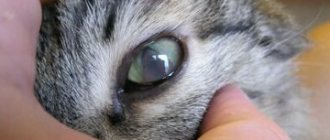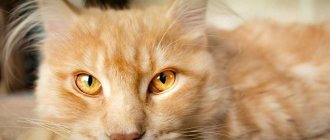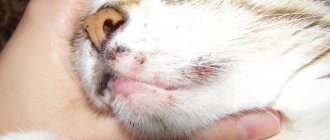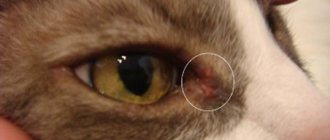Today there is no consensus among veterinarians about what causes the development of mastopathy in cats. However, most experts adhere to the theory that the determining factor is the presence in the body of an excess of two hormones: progesterone and prolactin. Treatment is prescribed depending on the symptoms of the disease and the complexity of its course.
Causes of mastopathy
The causes of the disease can be different, and often they complement each other or arise from one another. These include:
- Malfunctions of the endocrine system.
- Diseases of the liver and genitourinary system.
- Trauma to the birth canal, leading to infection in the uterus and pelvic organs.
- Injury to the mammary glands or nipples themselves during the feeding period of kittens.
- Hypothermia of the body.
- Excessive milk production during lactation and, as a result, its stagnation in the ducts of the mammary glands.
- False pregnancy due to severe nervous stress, usually after mating, estrus or stillbirth of kittens.
- General decrease in immunity during the postpartum period.
It has been noted that sterilized cats that have not been in heat have a minimal risk of developing mastopathy. Taking contraceptives also increases the likelihood of developing breast pathology. In males, such problems are extremely rare. Unneutered cats who have never been bred with a cat, but are actively “fed” with hormonal drugs, fall into the risk zone.
What should the owner be wary of?
In the final stages, cancer is difficult to confuse with anything:
- the glands are greatly enlarged;
- nodules are visible to the naked eye (with metastasis, they appear not only in the chest area, but throughout the body);
- bleeding and festering ulcers appear;
- the addition of a secondary infection is typical.
In this case, the cat is practically doomed and it is extremely difficult to save it. It’s another matter if a tumor in the chest can be detected at stages 1–2, when the chances of prolonging the animal’s life are quite high. The problem is that at the very beginning, oncology is asymptomatic or with unexpressed signs.
- small lumps in the area of the animal’s chest that were not noticed before (unfortunately, this sign of cancer can rarely be detected due to the small size of the cat’s mammary glands and the presence of hair that interferes with palpation);
- general deterioration in the animal’s well-being, frequent vomiting, poor appetite, sudden weight loss;
- manifestation of aggression in the cat’s behavior, depression, constant desire to hide;
- signs of breast tenderness (licking of the mammary glands, panic when a person tries to touch this area).
Cancer is often accompanied by constant nausea, vomiting, chronic hyperthermia, weakness
Treatment of a mammary tumor in a cat is practically useless in the final stages. The following symptoms indicate this:
- strong increase, lumpy, uneven;
- severe localization, nodules can appear throughout the body;
- open wounds, ulcers;
- addition of a secondary infection.
If a cat's mammary tumor has opened, this indicates a hopeless situation. Even if you surgically remove all the tape on both sides. Due to extensive metastasis to tissues and organs, new nodules are formed and gradually grow. At stages 3-4, cats are practically doomed.
At the very beginning, the breeder should be alert to the following symptoms:
- small dense nodules in the peripapillary area or along the band of the mammary glands. it is difficult to detect them visually, they are hidden by fur, so you need to carefully walk your fingers over the skin;
- the general unstable condition of the animal, the pet looks sick, apathetic, the fur is unkempt;
- there may be vomiting, poor appetite, sudden weight loss;
- aggression is rare, the cat hides in corners, wanting to hide;
- the pet often licks the affected area and does not allow itself to be examined, showing with all its appearance that it hurts there.
It is not necessary for the tumor to become large. In practice, there are cases when a cancerous tumor remained the size of a pea throughout the entire period of growth. It rushed deep into the body, metastasizing to the lungs, stomach, intestines and causing irreversible changes.
Clinical picture
Conventionally, mastopathy can be divided into several main types:
- Fibrous. Tissue growth occurs in the gland, which leads to its compaction.
- Cystic. Cysts form in the tissue, filled with fluid inside.
- Diffuse. Neoplasms are present throughout the mammary gland cavity, forming nodes.
General symptoms depend on the form of the disease and its neglect. Typically, the following symptoms are observed:
- The gland is hard, the nipples are enlarged.
- Visible swelling in the breast area.
- Moderate to severe pain when touching swollen areas.
- The presence of subcutaneous balls or bumps.
- Redness and dry skin.
- Enlarged lymph nodes.
- The skin tissue is hot and hard to the touch.
- Discharge of a watery fluid from the nipples, which may contain ichor or flakes.
- Increased body temperature.
- Fever.
What are breast tumors?
Breast cancer is a neoplasm of malignant or benign origin, characterized by uncharacteristic growth of breast tissue.
As a result, a neoplasm grows from an accumulation of pathological cells, which tends to rapidly increase. A benign tumor (1) is not prone to metastasis. Malignant tumor cells (2) spread throughout the body through the blood or lymph
Types of tumors:
- benign (adenoma, cyst), does not pose a direct threat to life, but in the complete absence of treatment it can cause a lot of inconvenience to the animal. The tumor is often encapsulated, regular in shape, and relatively easy to remove. Located on one lobe of the gland, it grows slowly, pushing apart the surrounding tissue. Direct danger is compression of surrounding tissues and organs with disruption of their functions;
- malignant (sarcoma, carcinoma) – the prognosis for it is unfavorable. The tumor not only grows, but also metastasizes to all organs and tissues, which forms new foci of tumors with the same properties. Externally, it has an irregular, lumpy shape and is difficult to undergo surgery from the 2nd-3rd stage.
Symptoms of this condition, unfortunately, are noticed by the owners late, when the breast cancer acquires visible contours, increases in size to its maximum, or tissue ulceration begins. It is important to understand that the outcome of the operation directly depends on at what stage the animal is operated on and how cleanly the malignant cells are removed.
Breast tumors can be benign or malignant (cancerous). The second type of breast tumors is distinguished by the ability to metastasize, that is, “capture” neighboring tissues and spread throughout the body through the blood and lymph. Benign tumors are clearly separated from healthy tissues and do not metastasize, but under the influence of factors (malnutrition, taking hormonal drugs, radiation, etc.) they can transform into malignant ones.
It is almost impossible to accurately distinguish a benign tumor from a malignant one based on external symptoms. The nature of the neoplasm is determined through microscopic examination of tissue taken during a biopsy.
There is a clear classification of breast tumors. Determining the type of tumor is important for drawing up a treatment plan.
Benign neoplasms in the mammary glands of cats:
- adenoma - uniform hyperplasia (growth) of the glandular epithelium in the chest of an animal;
- fibroma - compaction of connective tissue;
- lipoma – a “knot” of adipose tissue;
- fibrolipoma is a tumor of compaction of connective and adipose tissue.
Malignant tumors in the mammary glands of cats:
- carcinoma - uncontrolled cell division of the epithelium of the ducts and alveoli of the mammary glands, accompanied by inflammation of the surrounding tissues;
- mixed tumors - both ductal and epithelial tissues of the mammary glands grow;
- Soft tissue sarcoma is an aggressive type of cancer (its growth is explosive - it begins suddenly and has a progressive rate of spread), and is practically untreatable.
A benign tumor (1) is not prone to metastasis, cells of a malignant tumor (2) tend to “escape” to other organs through the blood or lymph.
The insidiousness of oncology is that in terms of external symptoms it is similar to other diseases of the mammary glands. For example, cystic mastopathy (a benign increase in fibrous tissue of the mammary glands) is common in cats. Scientists are inclined to believe that both cancer and mastopathy have the same causes of formation - mainly a deficiency of the hormone progesterone and an excess of estrogen.
Both pathologies are manifested by discomfort in the chest (this can be understood by the fact that the cat does not allow this part of the body to be touched and licks its mammary glands). The appearance of compacted nodules (single and multiple) is possible. Similar signs are also characteristic of mastitis (inflammation of the breast tissue), lactostasis in nursing cats. Only a veterinarian can make an accurate diagnosis after instrumental (ultrasound, CT) and cytological examination.
Diagnostics
After the initial examination of the animal, the veterinarian can establish the correct diagnosis, but in any case it must be supported by additional research. These include:
- Blood test for biochemistry, hormones, hematology.
- General urine analysis.
- Ultrasound, X-ray or MRI.
- Histology of formations.
Only after a comprehensive diagnosis is a final conclusion about the form and complexity of the disease issued, and appropriate treatment is prescribed. Such “reinsurance” is necessary in order not to confuse mastopathy with other diseases that have a similar clinical picture: neoplasia, lipoma, lymphadenitis.
Preventive actions
To prevent the development of this disease, cat owners should pay attention to the condition of the mammary glands and pouches. The greatest attention should be paid to examining the animal after giving birth and weaning kittens from the cat. In the room where the female is located, it is necessary to maintain a warm temperature and protect the animal from drafts. Doctors draw the attention of owners to the fact that they need to keep their pets clean. In addition, veterinarians from the VetHelp-Animals clinic claim that mastopathy in a cat after sterilization occurs much less frequently than in an unsterilized animal.
Treatment at home
The treatment regimen is prescribed after determining the cause of the pathology, as well as its type. It could be:
- Physiotherapeutic procedures - for example, electrophoresis or ultrasound. Effective in the early stages of the disease. They are often combined with novocaine blockades.
- Massage in combination with warm compresses of ichthyol and camphor oil. The effect of active substances on the area of the mammary glands contributes to the dilation of blood vessels and, as a result, a rush of blood to the tissues. Stagnation processes are reduced, inflammation is relieved, and the cat begins to feel much better. At the same time, painkillers and anti-inflammatory drugs are prescribed. This method of therapy is recommended for the treatment of serous and catarrhal forms of mastopathy.
- In more severe cases (fibrinous and purulent mastitis), antibiotics are prescribed. To check the cat’s reaction to a particular drug, it is advisable to test for sensitivity and allergies. Oxytocin helps remove stagnant fluid from the milk ducts. Disinfectant ointments are prescribed externally. If there are ulcers (abscess form), they are opened and then treated with antiseptics.
- Mastomethrin and Travmatin show themselves to be quite effective in practice. The first belongs to the category of homeopathic medicines and is used in the form of injections. Injections are given intramuscularly in the back thigh, 1.5 ml daily. The second has an anti-inflammatory effect and accelerates the process of regeneration of damaged tissues. It is administered subcutaneously 2 times a day, 1 ml for each injection. Both drugs are used in combination with other types of therapy: massage, pumping, warming.
Important: cats are not recommended to drink heavily during treatment. Restrictions in water intake can be compensated for by infusions of diuretic herbs. Thus, the animal will not suffer from thirst and at the same time get rid of excess swelling.
Surgical intervention
In the presence of an advanced stage of mastopathy, neoplasms can only be removed surgically. In the case of diagnosing bilateral lesions of the mammary glands, the operation is performed in two stages with a difference of 14 days. During the postoperative period, the cat is under the supervision of a doctor in a hospital setting to avoid complications.
In addition to the mammary gland, the uterus and both ovaries may be removed. In ninety percent of cases, the animal is completely cured and restored to normal life. However, it is worth remembering that the sooner help is provided, the greater the cat’s chances of regaining health.
There are a number of contraindications to surgical intervention:
- Age of the animal. It is not recommended to solve the problem surgically, as the cat may not tolerate anesthesia.
- If you have kidney and heart diseases.
- When other internal organs are affected by metastases. The operation can provoke the formation of new lesions and worsen the pet’s condition. In severe cases, the last method is used - euthanasia.
Possible complications and their consequences
We have already described all possible complications and their consequences, but let’s summarize:
- Very rarely, it is mastopathy that leads to severe mastitis (but usually the opposite is true).
- The most dangerous consequence is oncology. Even though the tumors in mastopathy are benign, there is no guarantee that they will not degenerate into cancer.
- Scar ties on the mammary glands. Even if there are no tumors in the remaining lobes, the cat will most likely no longer be able to feed the cubs.
Folk remedies in the treatment of mastopathy
You need to understand that the effect of homeopathy may be subtle, so you should not focus only on traditional methods of treatment. It is recommended to combine them with medication and physiotherapy.
- Flax seeds. 1/3 of a teaspoon of seeds is mixed with 10 g of water and poured down the cat’s throat. The procedure is carried out daily for a month. The first signs of improvement in health are observed two weeks after starting treatment.
- Elderberry juice. Use on an empty stomach with a dosage of ¼ tablespoon. Elderberry berries are rich in vitamins and biologically active substances, being an effective means of strengthening the immune system and extinguishing inflammatory processes. It is especially recommended to give to cats during the postpartum period, when there is a high risk of developing a relapse of the disease.
- Apricot kernels. They serve as a dietary supplement and are taken in parallel with medications. For one meal, two bones, crushed into small crumbs, are enough for the animal.
Prevention
Preventive measures in this case are aimed at preventing the development of the disease in any individual. Since it is not possible to predict mastopathy in the future, you can only resort to early sterilization of the cat. If this individual is of breeding value, it would be wiser to abandon this idea and cure it if this problem does occur.
The cat owner needs to make it a rule that he needs to monitor his behavior and life in general. If a cat behaves atypically or refuses to sleep in its place, you need to be sensitive. It is worth changing the bedding, reviewing the diet and showing the animal to the doctor. In this case, you can expect the cat to live a long and happy life.











